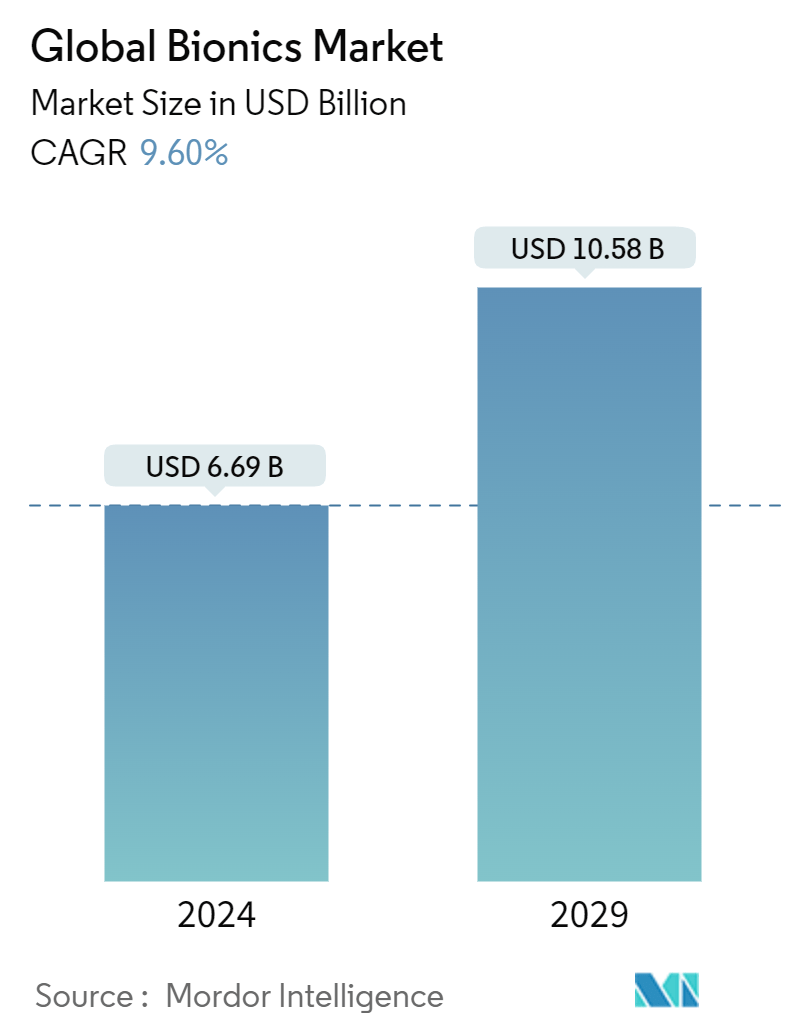Market Size of Global Bionics Industry

| Study Period | 2019 - 2029 |
| Market Size (2024) | USD 6.69 Billion |
| Market Size (2029) | USD 10.58 Billion |
| CAGR (2024 - 2029) | 9.60 % |
| Fastest Growing Market | Asia-Pacific |
| Largest Market | North America |
| Market Concentration | Low |
Major Players
*Disclaimer: Major Players sorted in no particular order |
Bionics Market Analysis
The Global Bionics Market size is estimated at USD 6.69 billion in 2024, and is expected to reach USD 10.58 billion by 2029, growing at a CAGR of 9.60% during the forecast period (2024-2029).
COVID-19 negatively impacted the bionics market. The pandemic caused added challenges for patients who are having some form of disabilities and organ failures. Due to social distancing, many hospitals were restricted to non-elective procedures and surgeries, and they were instead offering patients video conferencing with disabilities to overcome the limitations of the market growth. For instance, according to the research study published in September 2021 by Harper L. Wilson et al., during the COVID-19 pandemic, adult users of cochlear implants and people living in rural areas faced greater difficulties, including pandemic preparedness and access to healthcare, which has a detrimental effect on the market under study. However, the market under study is anticipated to reach its full potential over the forecast period due to ongoing vaccinations and a decline in COVID-19 cases.
Factors that are responsible for the growth of the market include increased incidence of disabilities and organ failures, technological advancements, and high incidence of road accidents leading to amputations. For instance, as per the data published by the World Health Organization in October 2021, approximately 2.2 billion people were affected with blindness or vision impairment, out of which at least 1 billion people had unaddressed or preventable conditions worldwide. Moreover, in 2020, there are 2.6 billion myopic individuals of all ages. Age-related macular degeneration has affected 195.6 million people between the ages of 30 and 97 in 2020. Thus the increasing prevalence of targeted disabilities, the market is likely to grow at a faster pace in upcoming years.
Another primary factor is the scarcity of donor organs. The lack of availability of potential organs to transplant has been a major issue. The demand for organ donors is increasing and is very high compared to the actual supply. Bionics are able to cater to the needs of those in need of organ transplantations and replacements. It can replicate the function of damaged organs. The replication is almost the same. This level of scarcity of organs has turned into a boon for artificial organs and the bionics industry.
Rising product approval and technological advancement in this industry are also likely to fuel the market growth in upcoming years. For instance, in 2020, Edwards Lifesciences Corporation announced that its KONECT RESILIA aortic valved conduit (AVC) received approval from the United States Food and Drug Administration (FDA) as the first ready-to-implant solution for bio-Bentall procedures. Additionally, in March 2020, Widex launched the Moment hearing device. The Widex Moment has the 'classic' Widex signal pathway, which is paired with a second ultra-fast signal pathway that adds extra gearing to the platform.
However, the factors such as the fear of device malfunction and its consequences, high cost of devices, and uncertain reimbursement scenarios, among others, may impact market growth.
Bionics Industry Segmentation
Bionics are artificial devices that can be implanted or integrated into humans to either replace a natural organ or provide support to restore a specific function, or a group of related functions, helping the patient to return to his normal life. The Bionics Market is segmented by Type of Bionics (Vision Bionics, Ear Bionics, Orthopedic Bionic, and Cardiac Bionics), Fixation (Implantable Bionics and External Bionics), and Geography (North America, Europe, Asia-Pacific, Middle-East and Africa, and South America). The market report also covers the estimated market sizes and trends for 17 different countries across major regions, globally. The report offers the value (in USD million) for the above segments.
| Type of Bionics | ||||||
| Vision Bionics | ||||||
| ||||||
| ||||||
|
| Fixation | |
| Implantable Bionics | |
| External Bionics |
| Geography | ||||||||
| ||||||||
| ||||||||
| ||||||||
| ||||||||
|
Global Bionics Market Size Summary
The bionics market is poised for significant growth over the forecast period, driven by factors such as the increasing incidence of disabilities, organ failures, and technological advancements. The market, which faced challenges during the COVID-19 pandemic due to restrictions on elective procedures and surgeries, is expected to recover and expand as vaccination efforts continue and COVID-19 cases decline. The scarcity of donor organs has also created a favorable environment for bionics, as artificial organs can effectively replicate the function of damaged ones. Technological innovations and product approvals, such as those by Edwards Lifesciences Corporation and Widex, are further propelling market growth. However, challenges like device malfunction fears, high costs, and uncertain reimbursement scenarios may impact the market's trajectory.
North America currently dominates the bionics market, with the United States leading due to its developed healthcare infrastructure and high prevalence of hearing loss. The region's market is supported by the rising demand for non-invasive surgical procedures and the presence of major market players like Medtronic PLC and Edward Lifesciences Corporation. The market's competitive landscape is moderately populated, with both major and emerging players contributing to its expansion. Innovations such as Prosthetics startup Unlimited Tomorrow's TrueLimb and Ceryx Medical's Cysoni device highlight the ongoing advancements in the industry. As the demand for medical bionics grows, the market is expected to witness substantial growth, driven by both technological progress and the increasing need for organ replacements.
Global Bionics Market Size - Table of Contents
-
1. MARKET DYNAMICS
-
1.1 Market Overview
-
1.2 Market Drivers
-
1.2.1 Increased Incidence of Disabilities and Organ Failures
-
1.2.2 Technological Advancements
-
1.2.3 High Incidence of Road Accidents Leading to Amputations
-
-
1.3 Market Restraints
-
1.3.1 High Cost of Devices and Uncertain Reimbursement Scenarios
-
1.3.2 Fear of Device Malfunction and Its Consequences
-
-
1.4 Porter's Five Forces Analysis
-
1.4.1 Threat of New Entrants
-
1.4.2 Bargaining Power of Buyers/Consumers
-
1.4.3 Bargaining Power of Suppliers
-
1.4.4 Threat of Substitute Products
-
1.4.5 Intensity of Competitive Rivalry
-
-
-
2. MARKET SEGMENTATION (Market Size by Value - USD million)
-
2.1 Type of Bionics
-
2.1.1 Vision Bionics
-
2.1.2 Ear Bionics
-
2.1.2.1 Cochlear Implant
-
2.1.2.2 Bone-anchored Hearing Aid (BAHA)
-
-
2.1.3 Orthopedic Bionic
-
2.1.3.1 Bionic Hand
-
2.1.3.2 Bionic Leg
-
-
2.1.4 Cardiac Bionics
-
2.1.4.1 Heart Valves
-
2.1.4.2 Ventricular-assisted Device
-
2.1.4.3 Pacemaker
-
2.1.4.4 Other Cardiac Bionics
-
-
-
2.2 Fixation
-
2.2.1 Implantable Bionics
-
2.2.2 External Bionics
-
-
2.3 Geography
-
2.3.1 North America
-
2.3.1.1 United States
-
2.3.1.2 Canada
-
2.3.1.3 Mexico
-
-
2.3.2 Europe
-
2.3.2.1 Germany
-
2.3.2.2 United Kingdom
-
2.3.2.3 France
-
2.3.2.4 Italy
-
2.3.2.5 Spain
-
2.3.2.6 Rest of Europe
-
-
2.3.3 Asia-Pacific
-
2.3.3.1 China
-
2.3.3.2 Japan
-
2.3.3.3 India
-
2.3.3.4 Australia
-
2.3.3.5 South Korea
-
2.3.3.6 Rest of Asia-Pacific
-
-
2.3.4 Middle-East and Africa
-
2.3.4.1 GCC
-
2.3.4.2 South Africa
-
2.3.4.3 Rest of Middle-East and Africa
-
-
2.3.5 South America
-
2.3.5.1 Brazil
-
2.3.5.2 Argentina
-
2.3.5.3 Rest of South America
-
-
-
Global Bionics Market Size FAQs
How big is the Global Bionics Market?
The Global Bionics Market size is expected to reach USD 6.69 billion in 2024 and grow at a CAGR of 9.60% to reach USD 10.58 billion by 2029.
What is the current Global Bionics Market size?
In 2024, the Global Bionics Market size is expected to reach USD 6.69 billion.

